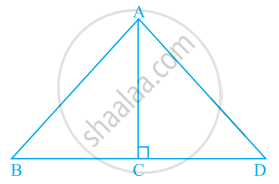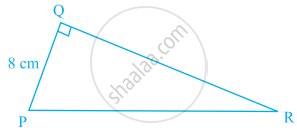Advertisements
Advertisements
प्रश्न
The points A(2, 9), B(a, 5) and C(5, 5) are the vertices of a triangle ABC right angled at B. Find the values of a and hence the area of ∆ABC.
उत्तर
Given that, the points A(2, 9), B(a, 5) and C(5, 5) are the vertices of a ΔABC right angled at B.
By Pythagoras theorem,
AC2 = AB2 + BC2
Now, by distance formula,
AB = `sqrt((a - 2)^2 + (5 - 9)^2)` ...(i) `[∵ "Distance between two point" (x_1, y_1) "and" (x_2, y_2) = sqrt((x_2 - x_1)^2 + (y_2 - y_1)^2)]`
= `sqrt(a^2 + 4 - 4a + 16)`
= `sqrt(a^2 - 4a + 20)`
BC = `sqrt((5 - a)^2 + (5 - 5)^2`
= `sqrt((5 - a)^2 + 0)`
= 5 – a
And AC = `sqrt((2 - 5)^2 + (9 - 5)^2`
= `sqrt((-3)^2 + (4)^2`
= `sqrt(9 + 16)`
= `sqrt(25)`
= 5
Put the values of AB, BC and AC in equation (i), we get
(5)2 = `(sqrt(a^2 - 4a + 20))^2 + (5 - a)^2`
⇒ 25 = a2 – 4a + 20 + 25 + a2 – 10a
⇒ 2a2 – 14a + 20 = 0
⇒ a2 – 7a + 10 = 0
⇒ a2 – 2a – 5a + 10 = 0 ...[By factorisation method]
⇒ a(a – 2) – 5(a – 2) = 0
⇒ (a – 2)(a – 5) = 0
∴ a = 2, 5
Here, a ≠ 5, since at a = 5, the length of BC = 0.
It is not possible because the sides AB, BC and CA form a right angled triangle.
So, a = 2
Now, the coordinate of A, B and C becomes (2, 9), (2, 5) and (5, 5), respectively.
∵ Area of ΔABC = `1/2[x_1(y_2 - y_3) + x_2(y_3 - y_1) + x_3(y_1 - y_2)]`
∴ Δ = `1/2[2(5 - 5) + 2(5 - 9) + 5(9 - 5)]`
= `1/2[2 xx 0 + 2(-4) + 5(4)]`
= `1/2(0 - 8 + 20)`
= `1/2 xx 12`
= 6
Hence, the required area of ΔABC is 6 sq units.
APPEARS IN
संबंधित प्रश्न
Find the area of the quadrilateral whose vertices, taken in order, are (-4, -2), (-3, -5), (3, -2) and (2, 3).
Find a relation between x and y if the points (x, y), (1, 2) and (7, 0) are collinear.
If G be the centroid of a triangle ABC and P be any other point in the plane, prove that PA2+ PB2 + PC2 = GA2 + GB2 + GC2 + 3GP2.
If the points A (x, y), B (3, 6) and C (−3, 4) are collinear, show that x − 3y + 15 = 0.
Let ∆ = `|("A"x, x^2, 1),("B"y, y^2, 1),("C"z, z^2, 1)|`and ∆1 = `|("A", "B", "C"),(x, y, z),(zy, zx, xy)|`, then ______.
The area of a triangle with vertices (a, b + c), (b, c + a) and (c, a + b) is ______.
Find the coordinates of the point Q on the x-axis which lies on the perpendicular bisector of the line segment joining the points A(–5, –2) and B(4, –2). Name the type of triangle formed by the points Q, A and B.
In the given figure, ratio of the area of triangle ABC to the area of triangle ACD is the same as the ratio of base BC of triangle ABC to the base CD of ΔACD.

In the given figure, area of ΔPQR is 20 cm2 and area of ΔPQS is 44 cm2. Find the length RS, if PQ is perpendicular to QS and QR is 5 cm.

Area of a triangle PQR right-angled at Q is 60 cm2 in the figure. If the smallest side is 8 cm long, find the length of the other two sides.

